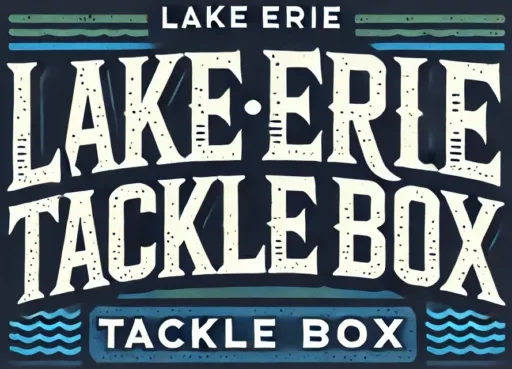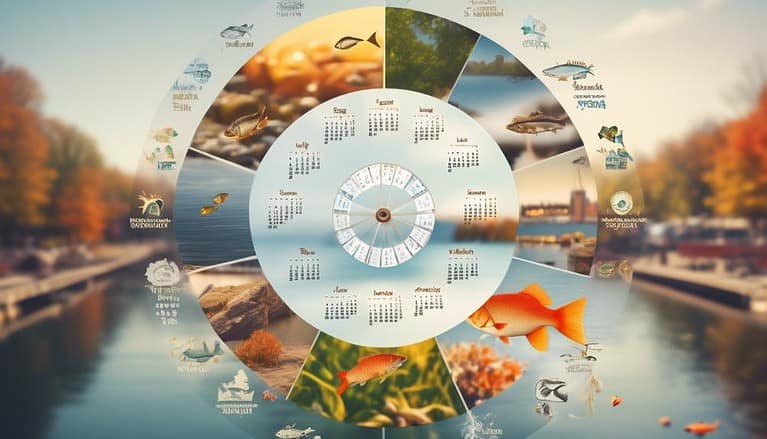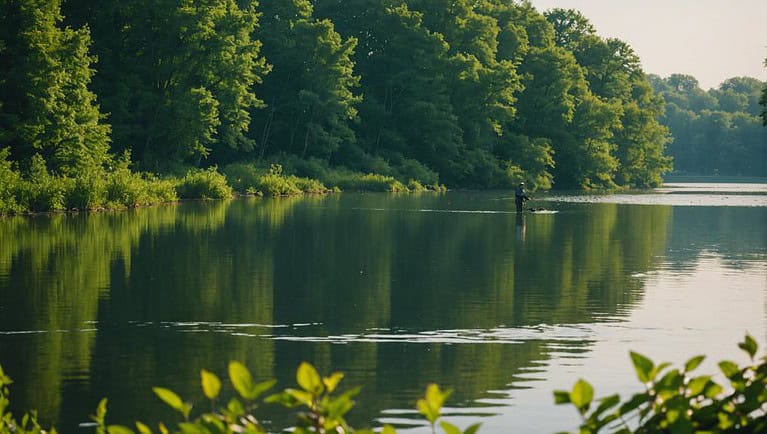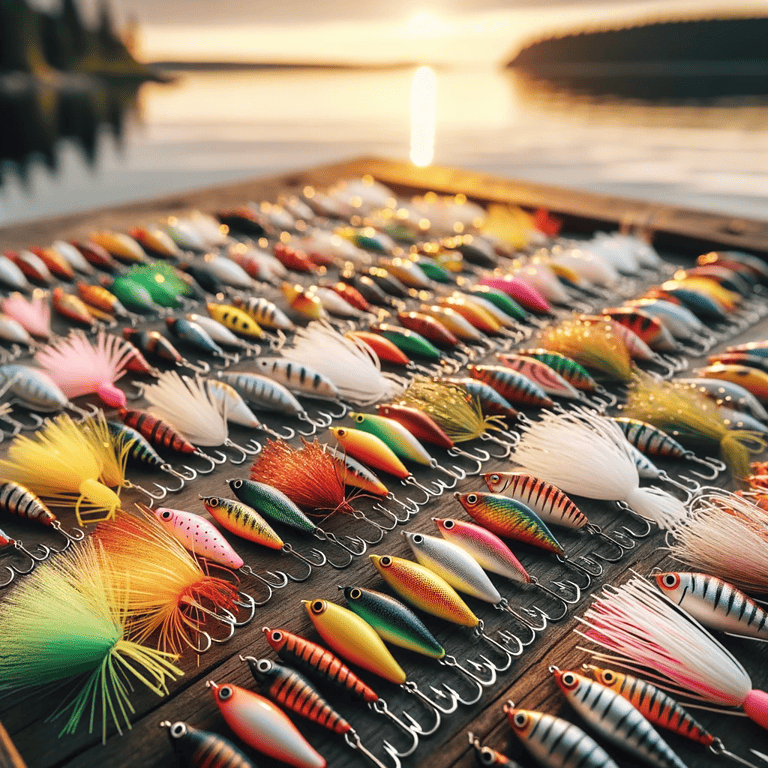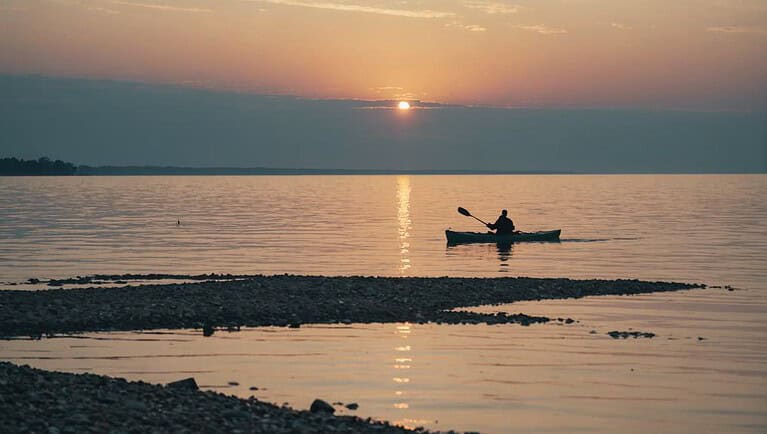Lake Erie Fishing Weather: How Conditions Affect Your Catch
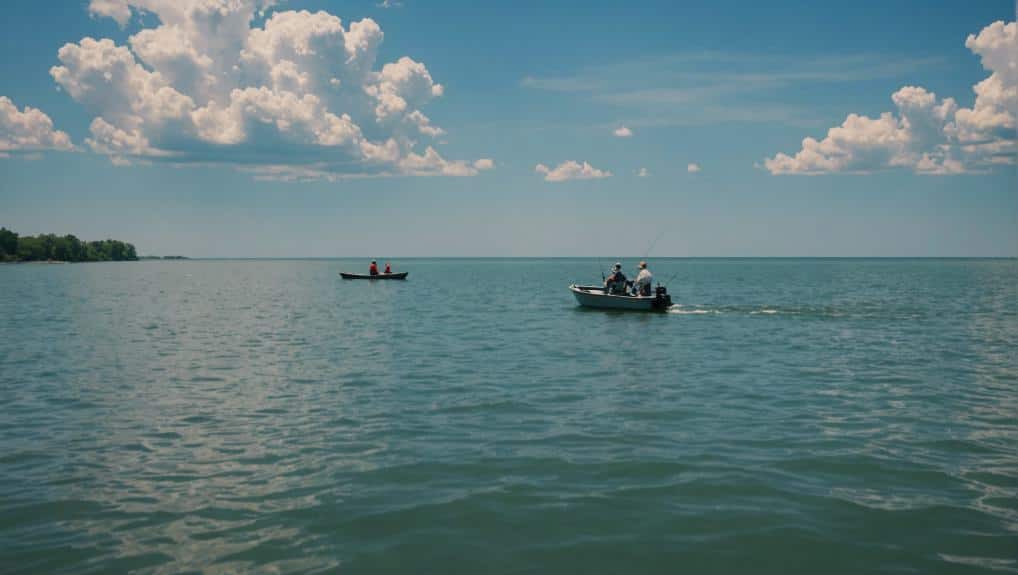
Understanding how Lake Erie fishing weather affects your catch involves analyzing several critical factors. Water temperature influences walleye metabolism and movement, with ideal ranges boosting activity. Wind patterns dictate fish behavior, affecting catch rates; southwest winds typically yield better results. Barometric pressure shifts can trigger feeding, making knowing pressure trends essential. Light sensitivity plays a role, with cloudy days often increasing fish activity due to lower water glare. Seasonal changes require specific strategies to adapt to fish migrations and activity levels. Monitoring these weather conditions and adapting your techniques accordingly will enhance your fishing success. Explore these factors in detail to boost your catch rate.
Main Points
- Water temperature directly affects walleye metabolism and habitat, with optimal fishing in temperatures ranging from 67°F to 72°F.
- Wind patterns influence fish activity; walleye are more active and easier to catch during moderate wind conditions.
- Cloud cover reduces water glare, making walleye more likely to feed; overcast days often yield better catch rates.
- Barometric pressure changes can alter fish behavior; stable or slowly falling pressure is generally best for fishing.
- Post-storm conditions often see increased fish activity as walleye become more aggressive feeders, improving catch opportunities.
Water Temperature
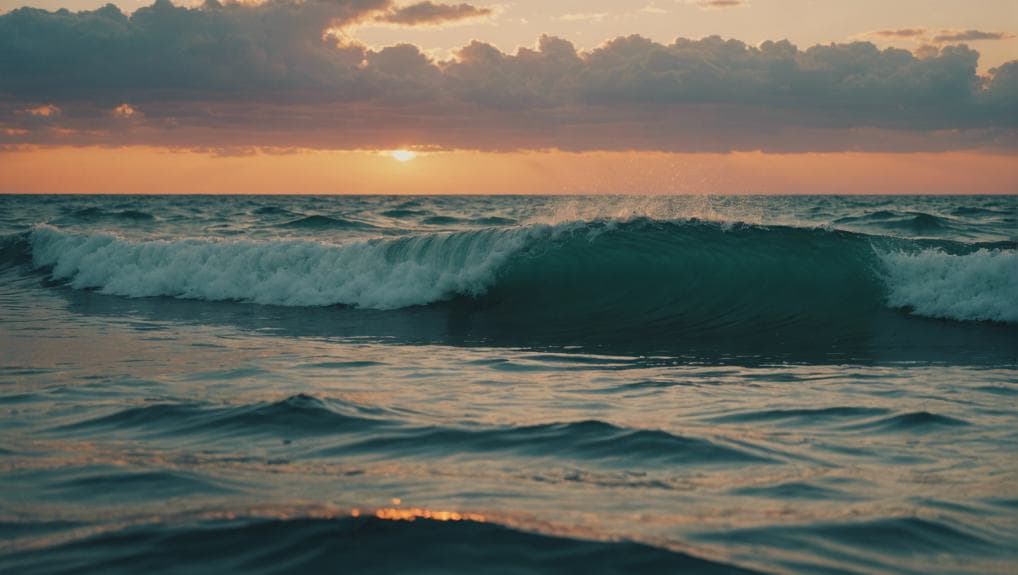
Understanding water temperature is essential for pinpointing walleye habitats in Lake Erie. Walleye exhibit distinct preferences for water temperatures ranging from 55°F to 70°F, which optimizes their metabolism and activity levels.
When the water temperature remains below 70°F, typically during spring and fall, expect walleye to inhabit shallower waters, up to 30 feet deep. This behavior is vital for strategizing your fishing techniques during these cooler periods.
During the warmer months, when water temperatures exceed 70°F, walleye will generally retreat to deeper waters beyond 30 feet. Monitoring real-time weather conditions and water temperature data can greatly enhance your fishing success.
For instance, if forecasts indicate rising temperatures, adjusting your fishing depth to target deeper habitats becomes essential. Consistency in your fishing approach, adapted to the prevailing water temperature, can markedly increase your catch rate.
Utilizing temperature-specific tactics won’t only help you locate walleye more efficiently but also make your fishing efforts more predictable and effective. By integrating water temperature data into your fishing strategy, you can optimize your efforts and improve your overall success in Lake Erie.
Wind Patterns
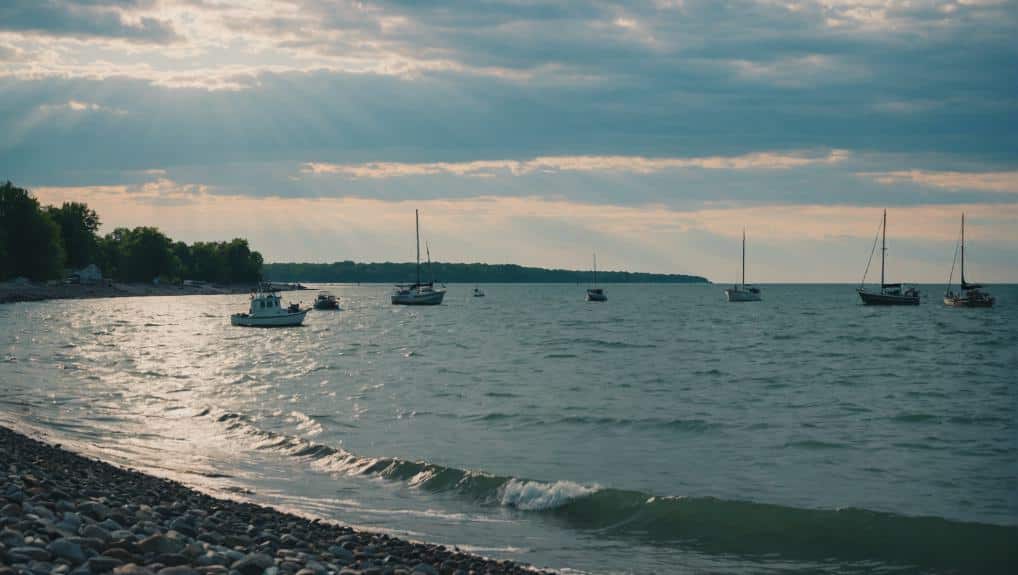
Wind patterns play an essential role in determining fishing outcomes on Lake Erie. By understanding wind direction, you can optimize your fishing strategy. An East wind can be particularly productive, pushing warm surface waters toward the western basin, where fish tend to gather. This wind direction often leads to increased fish activity, making it an opportune time for anglers.
However, a South wind generally doesn’t markedly impact fish behavior. While it may create some surface agitation, it doesn’t greatly influence the thermal layers or nutrient distribution in the water. Consequently, your catch rates may not vary much under these conditions.
West winds are often considered ideal for fishing on Lake Erie. They promote upwelling, bringing cooler, nutrient-rich waters to the surface and attracting fish to feed. Data suggests that fishing during West winds frequently results in higher catch rates, making it a preferred condition for many anglers.
Conversely, North winds are believed to deter fish activity. This wind direction tends to lower water temperatures and create rougher conditions, making fish less active and harder to catch.
Monitoring wind patterns and adjusting your fishing schedule accordingly can significantly improve your Lake Erie fishing experience.
Light Sensitivity
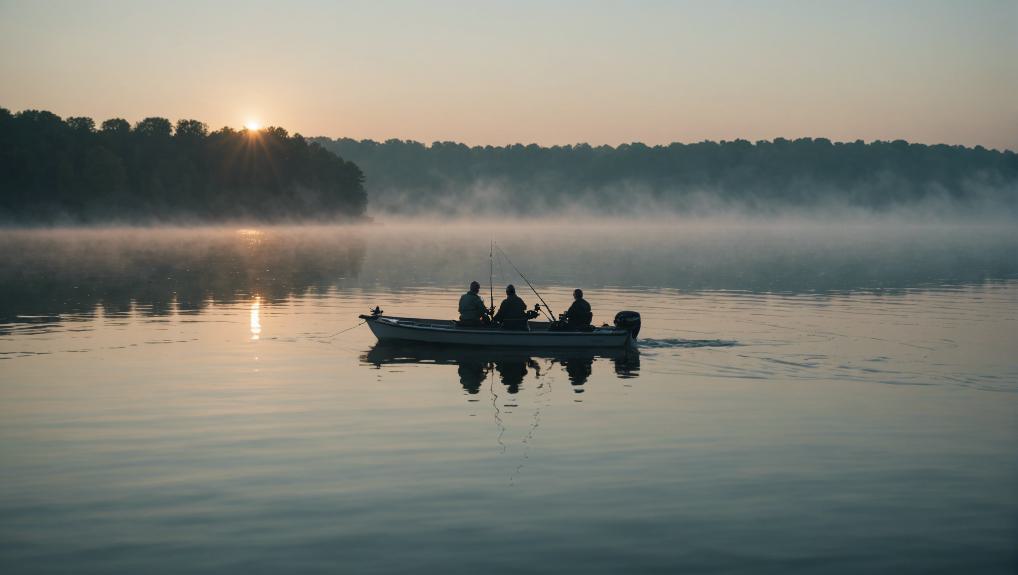
Walleye’s light-sensitive eyes, equipped with reflective tissue, give them a predatory advantage in low-light conditions, making dawn, dusk, and nighttime prime fishing times. These specialized eyes enhance their vision in dim waters, allowing walleye to hunt and feed effectively when light levels are low. Data shows that low-light conditions such as overcast days or murky waters greatly increase walleye activity.
During daylight hours, walleye exhibit a behavior pattern where they move towards darker, deeper waters to optimize their visibility. This migration is driven by their sensitivity to light, which makes them less active in bright conditions. For anglers, understanding these light-dependent habits is essential for successful fishing. By targeting areas where light penetration is minimal, particularly during early morning, late evening, or night, you can improve your catch rates.
Forecasts indicate that winter months, with their longer nights and often overcast skies, provide ideal conditions for night fishing. Data-driven strategies, such as using lures that reflect minimal light or fishing near structures that create shadows, can further enhance your chances of landing more walleye.
Adjusting your fishing times and locations based on light conditions is key to maximizing your success on Lake Erie.
Barometric Pressure
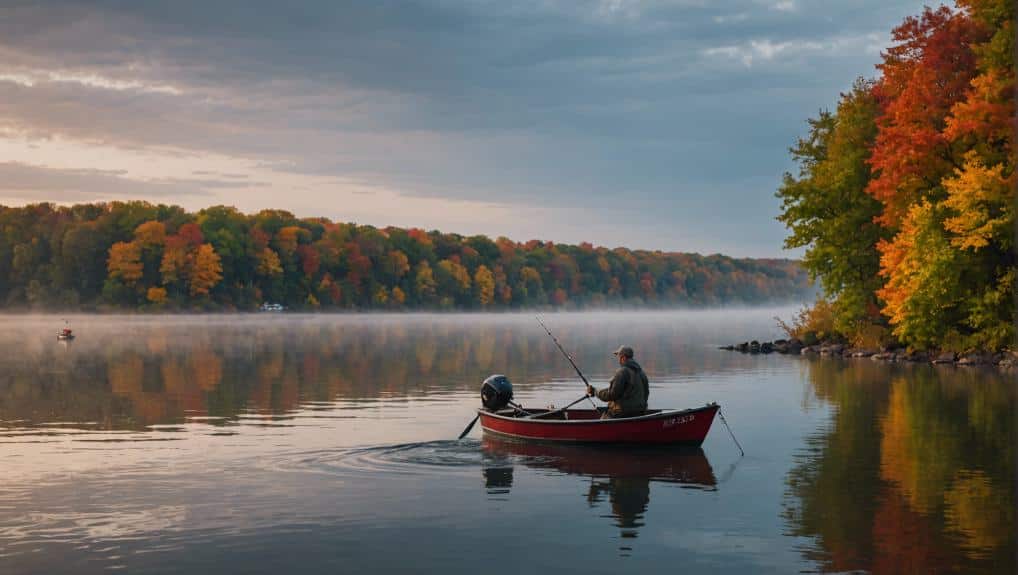
Monitoring barometric pressure fluctuations can greatly enhance your fishing strategy on Lake Erie. Changes in barometric pressure directly impact fish behavior, making them a critical factor to take into account.
When barometric pressure falls, fish typically become more active and increase their feeding activity. This is because falling pressure creates water currents that activate the food chain, causing baitfish to move and attract larger predators.
Conversely, rising barometric pressure tends to reduce fish feeding activity. Fish often become lethargic, seeking deeper, more stable water where pressure changes are less pronounced. By keeping an eye on barometric pressure trends, you can predict these activity levels more precisely and adapt your fishing strategy accordingly.
For instance, a sudden drop in barometric pressure signals an ideal time to cast your lines, as fish are likely to be more aggressive and plentiful. On the other hand, when you notice a steady rise in barometric pressure, it might be wise to adjust your tactics, perhaps by targeting deeper water or using different bait to entice sluggish fish.
Adaptability based on barometric pressure changes can significantly enhance your catch rate on Lake Erie.
Seasonal Changes
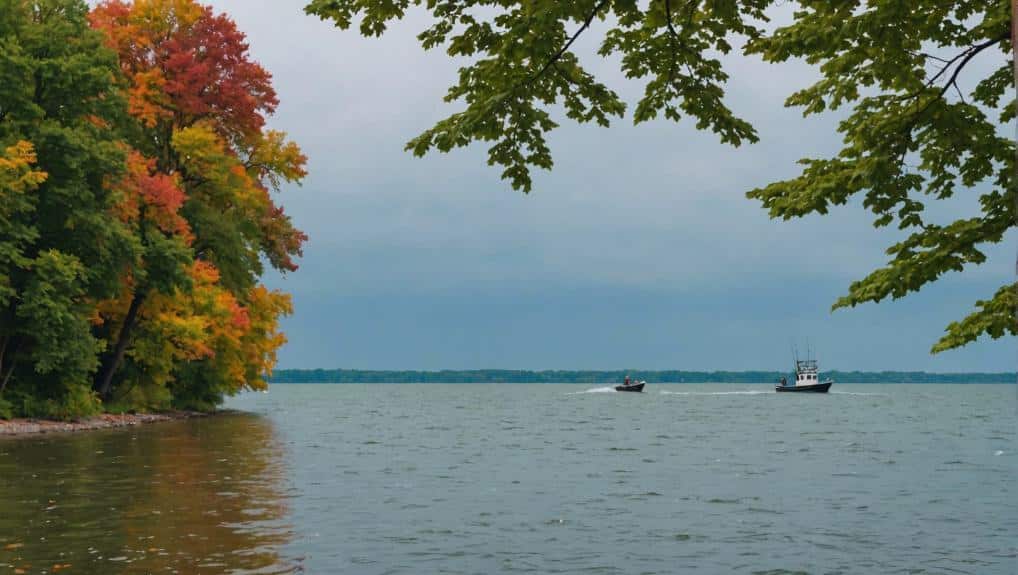
Seasonal changes on Lake Erie have a notable impact on water temperature and fish behavior, necessitating adjustments in your fishing strategy throughout the year. In spring, rising water temperatures signal increased fish activity, making it an ideal time for targeting species like walleye and smallmouth bass. As the lake warms, these fish move to shallower areas, enhancing your chances of a successful catch.
During summer, Lake Erie’s water temperatures stabilize, leading to consistent fishing patterns. Fish tend to inhabit mid-depths where temperatures are moderate, and their feeding activity becomes predictable. Monitoring weather changes is important; stable weather often correlates with steady fish behavior, but sudden shifts can disrupt patterns.
Come fall, declining temperatures trigger significant changes. Cooler waters prompt fish to migrate and adjust their feeding habits, often moving towards deeper or warmer sections of the lake. This is a critical period for targeting migratory species like steelhead.
Winter brings the coldest water temperatures, pushing fish to the lake’s deeper areas for warmth. Ice fishing becomes a prevalent method, demanding specialized gear and knowledge of underwater structures. Understanding these seasonal dynamics ensures you adapt your approach effectively, optimizing your catch year-round.
Cloud Cover

When planning your Lake Erie fishing trip, closely monitor cloud cover to optimize your strategy. Overcast conditions typically increase fish activity and feeding, while clear skies might make fish more cautious.
Optimal Cloudy Conditions
Under ideal cloudy conditions, fish behavior is greatly influenced as reduced visibility and a sense of security drive them to feed more actively. Cloud cover plays an important role in modifying feeding patterns. With less direct light penetration, fish are more comfortable moving closer to the surface, making shallow areas prime spots for anglers. Research indicates that overcast conditions can boost feeding activity by up to 30%, enhancing your chances of a successful catch.
Cloudy weather also stabilizes water temperature by blocking direct sunlight. This creates a more consistent thermal environment, which fish prefer. Stable temperatures can lead to prolonged feeding windows, allowing you to capitalize on fish that are less likely to retreat to deeper, cooler waters. Additionally, decreased water glare in cloudy conditions makes it easier for you to spot fish and detect subtle movements, optimizing your overall fishing strategy.
Forecasting when these favorable cloudy conditions will occur can be a game-changer. Check local weather reports for extended periods of cloud cover, especially during early morning and late afternoon when fish are naturally more active. By aligning your fishing trips with these conditions, you increase your probability of a rewarding outing on Lake Erie.
Overcast Vs. Clear Skies
Overcast skies offer a key advantage for anglers by reducing water glare and stabilizing temperatures, making fish less cautious and more likely to feed actively. When the sky is cloud-covered, the fish experience less visual stress, encouraging them to venture into shallower waters. This increases your chances of a successful catch.
Additionally, overcast conditions help maintain stable water temperatures, which is vital for consistent fish activity.
Barometric pressure also plays an important role. Overcast conditions typically mean low or falling barometric pressure, which signals fish to feed more aggressively. On the other hand, clear skies often correlate with high or rising barometric pressure, causing fish to become lethargic and retreat to deeper waters.
Wind speed is another critical factor. Overcast days often have moderate wind speeds that create a ripple effect, making the water surface less transparent and hiding your fishing line. This results in fish being less spooked and more likely to bite.
Conversely, clear skies and calm winds can make fish more alert to potential threats, reducing their likelihood of approaching your bait.
Understanding these elements can greatly enhance your fishing strategy, making overcast days particularly advantageous for anglers on Lake Erie.
Cloud Cover Impact
Analyzing cloud cover is critical, as it directly influences water temperature by blocking or allowing sunlight to penetrate, thereby affecting fish behavior on Lake Erie. When you observe overcast skies, note that fish often feel more secure and exhibit increased feeding activity. Cloud cover reduces water visibility, which can make it harder for fish to spot your lures or bait. Consequently, using brightly colored or larger lures might enhance your chances of a successful catch.
Different fish species react uniquely to variations in cloud cover. For instance, walleye tend to be more active under cloudy conditions, while smallmouth bass might require different tactics. Monitoring cloud cover patterns closely will enable you to anticipate these behavioral shifts. Keep an eye on weather pressure changes as well since these, combined with cloud cover, can significantly affect fish movement and feeding habits.
Incorporate real-time data on cloud cover and weather pressure into your fishing strategy. Accessing accurate forecasts and understanding how these elements interplay will optimize your approach. Adjust your tactics based on the prevailing conditions, and you’ll increase your odds of a fruitful fishing trip on Lake Erie.
Precipitation Effects
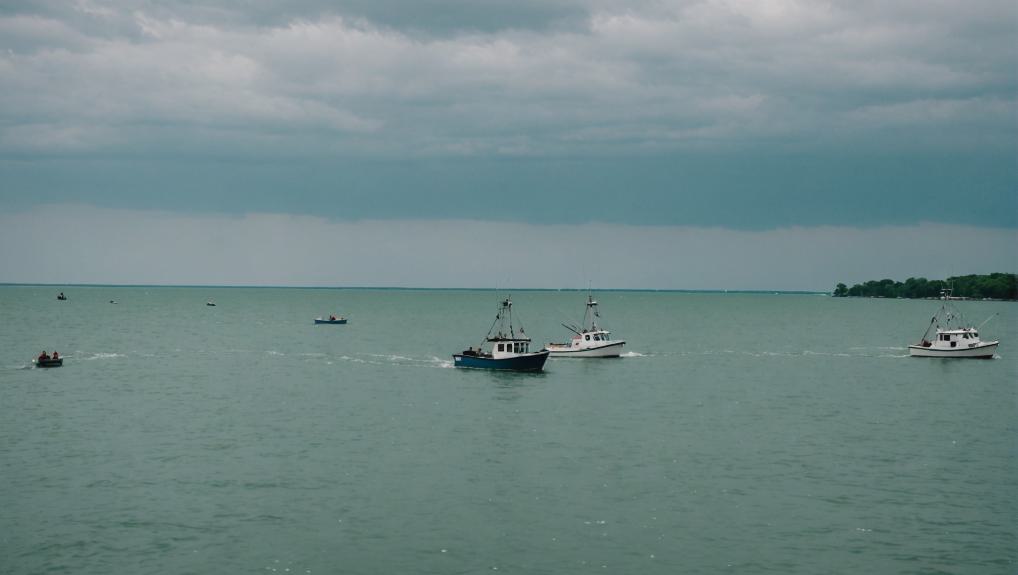
You should monitor precipitation closely, as rain can alter water temperature and affect fish activity greatly.
Snow impacts bait availability and effectiveness, requiring adjustments in your fishing strategy.
Additionally, storms necessitate strict safety measures to guarantee a secure fishing experience on Lake Erie.
Rainfall and Fish Activity
When rainfall hits Lake Erie, it rapidly alters water temperature and clarity, greatly influencing fish activity and feeding patterns. Rainfall can cause a sudden drop in water temperature, which may make fish more lethargic initially. However, as the rain continues, the influx of cooler water can also mix with warmer surface layers, creating more favorable conditions for fish activity.
Heavy rainfall often increases water turbidity, making it harder for fish to see bait. This reduced visibility can alter their feeding behavior, requiring you to use more vibrant or scented lures to attract their attention. Additionally, rain can wash nutrients into the water, which can lead to an increase in plankton and other food sources. Fish will often become more active during and after rainfall, seeking out these newly available nutrients.
Monitoring local weather forecasts can help you predict these changes. For instance, a series of heavy showers can transform a previously clear water scenario into a murky one, requiring a shift in your fishing strategy. Understanding these dynamics allows you to adapt quickly, optimizing your chances of a successful catch.
Always consider how rainfall impacts both water temperature and clarity to enhance your fishing outcomes.
Snow Impact on Bait
Snowfall greatly alters fishing conditions by rapidly changing water temperature and clarity, which in turn affects bait visibility and fish activity. When snow falls, it can cool the water quickly, making fish more lethargic and less likely to pursue bait actively.
This sudden temperature drop can also cause water to become murkier, reducing the visibility of your bait and making it harder for fish to locate it.
Here are some key points to take into account when snow impacts your fishing trip:
- Water Temperature Fluctuations: Snowfall can lower water temperatures rapidly, making fish sluggish and less inclined to chase bait.
- Decreased Visibility: Snow can cause water to become cloudy, making it challenging for fish to see your bait.
- Bait Presentation: With reduced visibility, you’ll need to use brighter or larger bait to increase your chances of being noticed.
- Ice Formation: Snow can lead to ice formation, which restricts access to certain fishing areas and complicates bait presentation.
- Feeding Patterns: Fish may alter their feeding patterns due to lower visibility and colder temperatures, impacting when and where they bite.
Storms and Safety Measures
During stormy weather, heavy precipitation can drastically reduce water clarity and alter fish behavior, making fishing more challenging and hazardous. Sudden storms on Lake Erie can create strong winds and high waves, posing significant risks to boaters. Understanding these conditions and implementing appropriate safety measures are vital for a safe fishing experience.
| Condition | Impact on Fishing | Safety Measures |
|---|---|---|
| Heavy Precipitation | Reduced visibility | Use radar and GPS |
| Strong Winds | Unsteady boat | Secure all gear |
| High Waves | Increased capsizing risk | Wear life jackets |
| Sudden Storms | Rapid weather changes | Monitor forecasts |
Monitoring weather forecasts is essential. Before you head out, check for any storm warnings or advisories. If you notice stormy weather approaching, it’s best to head back to shore immediately. Make sure your boat is equipped with necessary safety gear, including life jackets, a first aid kit, and communication devices.
In addition, having a stormy weather contingency plan can make a difference. Know the nearest safe harbors and have a clear plan on how to reach them quickly. By staying informed and prepared, you can mitigate the risks associated with fishing during stormy weather on Lake Erie.
Fishing After Storms
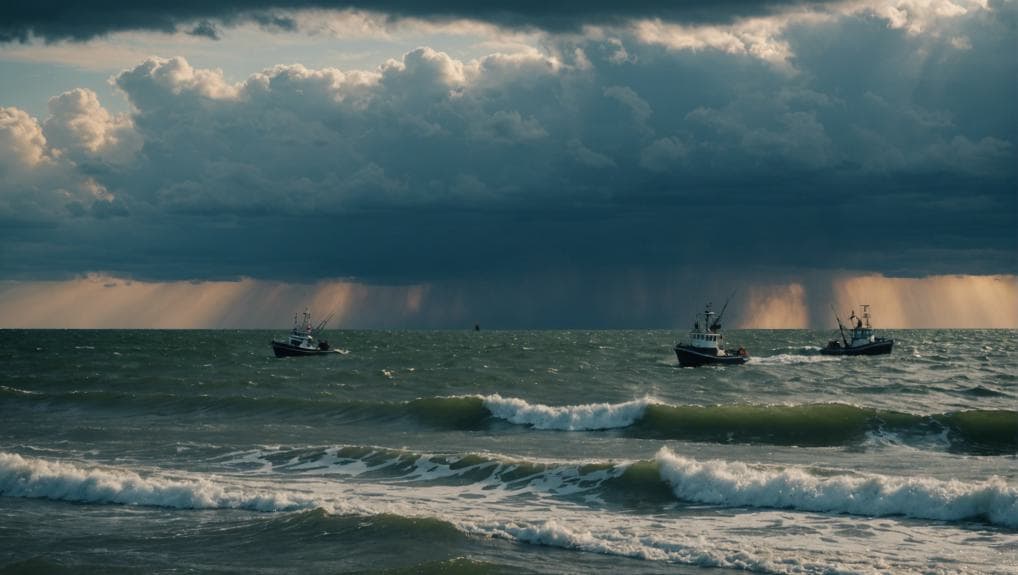
Post-storm fishing often yields higher catch rates as fish become more active and aggressive in their search for food. After a storm, the underwater environment undergoes significant changes that can impact fish behavior. Barometric pressure drops associated with cold fronts play a pivotal role in these shifts. When the pressure falls, fish sense the change and often feed more aggressively before conditions settle.
Storms can also disrupt underwater habitats, leading to altered feeding patterns and increased movement. The aftermath of a storm often results in clearer water conditions, allowing fish to easily spot your bait. Additionally, stronger currents and water movement created by the storm can influence where fish congregate, making them more opportunistic and willing to bite.
Here are some key factors to consider when fishing after storms:
- Barometric Pressure: Lower pressure post-storm can trigger feeding frenzies.
- Cold Fronts: These can cause significant drops in temperature, influencing fish activity.
- Clearer Water: Post-storm clarity improves bait visibility.
- Currents: Increased water movement can concentrate fish in certain areas.
- Disrupted Habitats: Fish may relocate, leading to varied and unpredictable feeding patterns.
Timing Your Trip
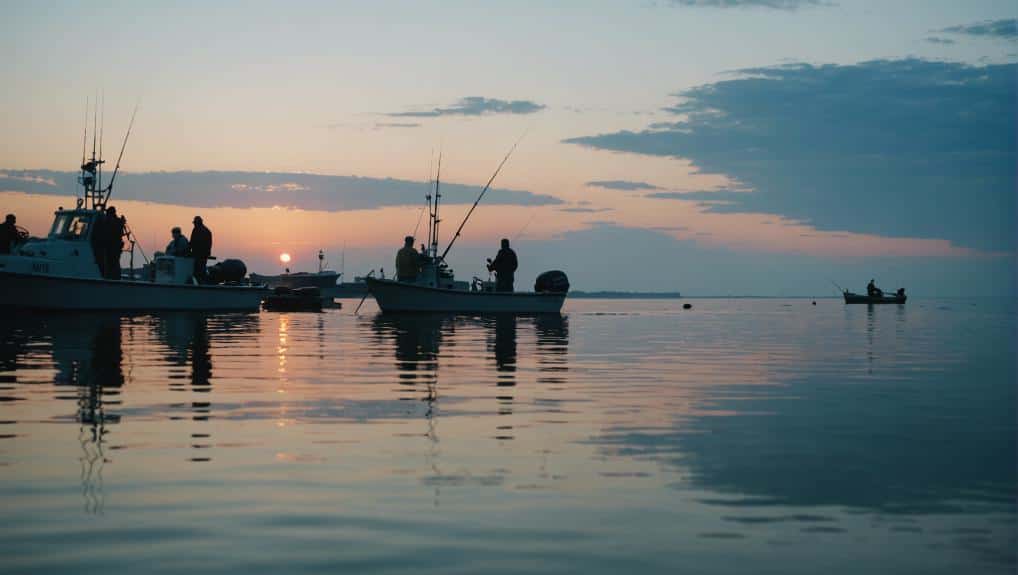
When planning your Lake Erie fishing trip, you’ll want to target seasonal peak times and ideal weather conditions.
Data indicates that stable barometric pressure and specific wind directions can greatly enhance your catch rate.
Utilize weather forecasting tools like Windy to identify these perfect periods and adjust your strategy accordingly.
Seasonal Best Fishing Times
Ideal fishing times on Lake Erie hinge on understanding the interplay between water temperatures and fish behavioral patterns throughout the year. Water temperature greatly influences fish activity, while atmospheric pressure changes can also impact their feeding routines.
In spring, walleye fishing peaks as the fish spawn in warmer, shallow waters. The fall season offers another prime window for walleye due to their increased feeding activity in preparation for winter.
During summer, smallmouth bass become more active as water temperatures rise, making these months ideal for targeting this species. Early morning and late evening in summer provide the best conditions because fish are more likely to be near the surface where water temperatures and pressure are favorable.
To maximize your fishing success, consider the following seasonal tips:
- Spring: Target walleye in shallow, warmer waters during spawning.
- Summer: Focus on smallmouth bass in deeper waters during midday heat.
- Fall: Catch walleye as they feed aggressively before winter.
- Early Morning: Fish are near the surface, making them easier to catch.
- Late Evening: Cooler water temperatures encourage fish to feed.
Optimal Weather Conditions
Timing your fishing trip on Lake Erie hinges on understanding and anticipating specific weather conditions like essential barometric pressure and favorable winds. Monitoring barometric pressure is critical as it directly impacts fish behavior. Stable pressure often correlates with consistent fish activity, while sudden drops can make them less active. You’ll want to plan your outings during periods of stable or slowly changing pressure to maximize your catch.
Wind direction and speed play significant roles in fishing success. Moderate winds, typically between 5 to 15 mph, can be advantageous. They help create water currents that stimulate fish feeding. However, be cautious of strong winds exceeding 20 mph, which can make fishing difficult and unsafe. Southerly and westerly winds are generally beneficial on Lake Erie, as they promote nutrient-rich upwellings that attract fish closer to the surface.
Using weather forecasts, you can pinpoint these favorable conditions. Services that provide real-time barometric pressure readings and wind forecasts are invaluable tools. By leveraging this data, you’ll enhance your chances of a successful and productive fishing trip on Lake Erie.
Don’t leave it to chance; let the weather guide your planning.
Adapting Techniques

Adapting your fishing techniques to the specific wind speed and direction is essential for maximizing your catch in Lake Erie. Wind speed can greatly alter walleye behavior, often requiring slower lure movements to entice bites. High wind speeds can churn up the water, making fish more cautious. Meanwhile, low barometric pressure usually leads to increased fish activity, but it can also make them more selective about bait presentation.
Stay versatile by:
- Slowing Down Your Lure: Windy conditions necessitate more deliberate movements to attract attention.
- Adjusting Bait Presentations: Change your bait type to match the walleye’s mood as weather shifts.
- Monitoring Barometric Pressure: Use a barometer to track pressure changes and modify your strategy accordingly.
- Positioning Strategically: Fish upwind or downwind based on the current conditions for best results.
- Staying Informed: Use real-time weather data to adapt your tactics on the fly.
In addition to wind speed and barometric pressure, consider how these elements interact with other weather conditions. For example, a sudden drop in pressure typically signals a storm, making fish more aggressive but harder to locate.
Conclusion
To sum up, understanding Lake Erie’s fishing conditions is like holding the key to a treasure chest. Monitor water temperature, wind patterns, and light sensitivity—these elements are your compass.
Track barometric pressure and seasonal changes for valuable insights.
Be mindful of precipitation and capitalize on post-storm opportunities.
Time your trips wisely and adapt techniques as needed.
By mastering these variables, you’ll increase your chances of a bountiful catch, making every outing a calculated adventure.
